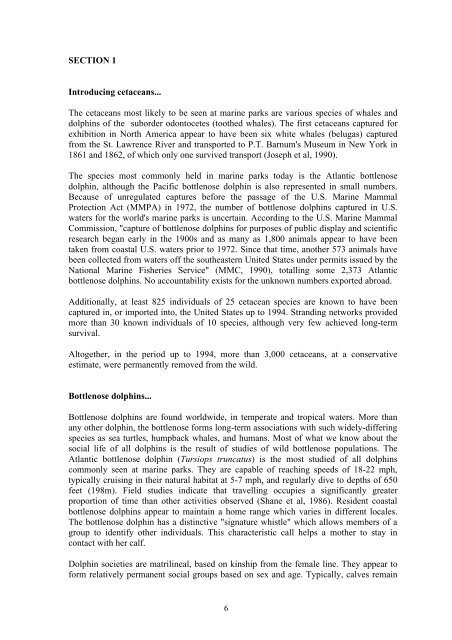Captive Cetaceans: A Handbook for Campaigners - Whale and ...
Captive Cetaceans: A Handbook for Campaigners - Whale and ...
Captive Cetaceans: A Handbook for Campaigners - Whale and ...
Create successful ePaper yourself
Turn your PDF publications into a flip-book with our unique Google optimized e-Paper software.
SECTION 1<br />
Introducing cetaceans...<br />
The cetaceans most likely to be seen at marine parks are various species of whales <strong>and</strong><br />
dolphins of the suborder odontocetes (toothed whales). The first cetaceans captured <strong>for</strong><br />
exhibition in North America appear to have been six white whales (belugas) captured<br />
from the St. Lawrence River <strong>and</strong> transported to P.T. Barnum's Museum in New York in<br />
1861 <strong>and</strong> 1862, of which only one survived transport (Joseph et al, 1990).<br />
The species most commonly held in marine parks today is the Atlantic bottlenose<br />
dolphin, although the Pacific bottlenose dolphin is also represented in small numbers.<br />
Because of unregulated captures be<strong>for</strong>e the passage of the U.S. Marine Mammal<br />
Protection Act (MMPA) in 1972, the number of bottlenose dolphins captured in U.S.<br />
waters <strong>for</strong> the world's marine parks is uncertain. According to the U.S. Marine Mammal<br />
Commission, "capture of bottlenose dolphins <strong>for</strong> purposes of public display <strong>and</strong> scientific<br />
research began early in the 1900s <strong>and</strong> as many as 1,800 animals appear to have been<br />
taken from coastal U.S. waters prior to 1972. Since that time, another 573 animals have<br />
been collected from waters off the southeastern United States under permits issued by the<br />
National Marine Fisheries Service" (MMC, 1990), totalling some 2,373 Atlantic<br />
bottlenose dolphins. No accountability exists <strong>for</strong> the unknown numbers exported abroad.<br />
Additionally, at least 825 individuals of 25 cetacean species are known to have been<br />
captured in, or imported into, the United States up to 1994. Str<strong>and</strong>ing networks provided<br />
more than 30 known individuals of 10 species, although very few achieved long-term<br />
survival.<br />
Altogether, in the period up to 1994, more than 3,000 cetaceans, at a conservative<br />
estimate, were permanently removed from the wild.<br />
Bottlenose dolphins...<br />
Bottlenose dolphins are found worldwide, in temperate <strong>and</strong> tropical waters. More than<br />
any other dolphin, the bottlenose <strong>for</strong>ms long-term associations with such widely-differing<br />
species as sea turtles, humpback whales, <strong>and</strong> humans. Most of what we know about the<br />
social life of all dolphins is the result of studies of wild bottlenose populations. The<br />
Atlantic bottlenose dolphin (Tursiops truncatus) is the most studied of all dolphins<br />
commonly seen at marine parks. They are capable of reaching speeds of 18-22 mph,<br />
typically cruising in their natural habitat at 5-7 mph, <strong>and</strong> regularly dive to depths of 650<br />
feet (198m). Field studies indicate that travelling occupies a significantly greater<br />
proportion of time than other activities observed (Shane et al, 1986). Resident coastal<br />
bottlenose dolphins appear to maintain a home range which varies in different locales.<br />
The bottlenose dolphin has a distinctive "signature whistle" which allows members of a<br />
group to identify other individuals. This characteristic call helps a mother to stay in<br />
contact with her calf.<br />
Dolphin societies are matrilineal, based on kinship from the female line. They appear to<br />
<strong>for</strong>m relatively permanent social groups based on sex <strong>and</strong> age. Typically, calves remain<br />
6

















